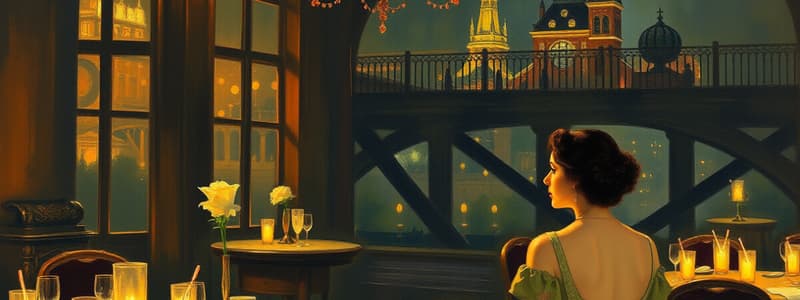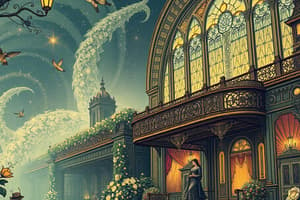Podcast
Questions and Answers
What do Gatsby's guests represent when they are drawn to his parties?
What do Gatsby's guests represent when they are drawn to his parties?
- Bugs attracted to garbage
- Moths drawn to light (correct)
- Birds searching for food
- Fish swimming in schools
What does 'repairing the ravages of the night before' imply about Gatsby's parties?
What does 'repairing the ravages of the night before' imply about Gatsby's parties?
They are wild and chaotic.
What do the discarded halves of oranges and lemons symbolize in the context of Gatsby's lifestyle?
What do the discarded halves of oranges and lemons symbolize in the context of Gatsby's lifestyle?
Rampant consumerism of the 1920s.
Food is crowded onto tables ____ the extravagance of Gatsby's parties.
Food is crowded onto tables ____ the extravagance of Gatsby's parties.
Nick is depicted as being sincere and straightforward.
Nick is depicted as being sincere and straightforward.
What feeling does Nick express when he mentions wanting to be special to Gatsby?
What feeling does Nick express when he mentions wanting to be special to Gatsby?
Flashcards
Gatsby's guests symbolize?
Gatsby's guests symbolize?
Represents people drawn to wealth and glamour.
'Ravages of the night' imply?
'Ravages of the night' imply?
Gatsby's parties are excessively wild and chaotic events.
Discarded oranges/lemons?
Discarded oranges/lemons?
Symbolizes the careless consumption of the wealthy during the 1920s.
Food on tables shows...
Food on tables shows...
Highlights the lavish and over-the-top nature of the parties.
Signup and view all the flashcards
Nick, sincere and straightforward?
Nick, sincere and straightforward?
Nick is not always sincere or straightforward; he is often biased.
Signup and view all the flashcards
Nick's desire for Gatsby?
Nick's desire for Gatsby?
Nick desires a special, unique connection with Gatsby.
Signup and view all the flashcardsStudy Notes
Gatsby's Parties
- Guests are attracted to Gatsby’s extravagant lifestyle, likened to moths drawn to a flame.
- The atmosphere at Gatsby's parties is lively, yet superficial, highlighting the allure of wealth and social status.
- Parties are characterized by a chaotic and wild nature, illustrating the excesses of the Jazz Age.
Consumerism and Waste
- The imagery of discarded fruit reflects the rampant consumerism of the 1920s.
- Leftover oranges and lemons symbolize the futility of excess; once vibrant, they become mere waste.
- Gatsby's disregard for such remnants indicates his disconnection from genuine values amidst material abundance.
Extravagance and Excess
- The lavish spread of food at parties epitomizes the theme of wastefulness; gourmet items are piled together with no thought for nourishment.
- The juxtaposition of various dishes illustrates both the opulence and the lack of meaning in the culinary offerings at Gatsby’s gatherings.
Narration and Perspective
- Nick Carraway's tone is often sarcastic, providing a critical lens on the characters and events around him.
- His use of phrases like "trembling opal" conveys mockery and a sense of detachment from the extravagance.
Nick's Relationship with Gatsby
- Nick seeks to establish a unique connection with Gatsby, distinguishing himself from the countless uninvited guests.
- His recognition of being one of the few invited signifies a desire for intimacy and authenticity in a world filled with superficiality.
Studying That Suits You
Use AI to generate personalized quizzes and flashcards to suit your learning preferences.




